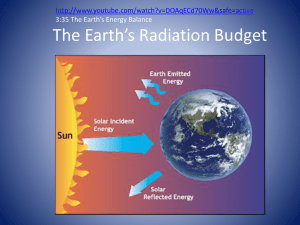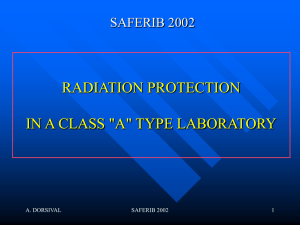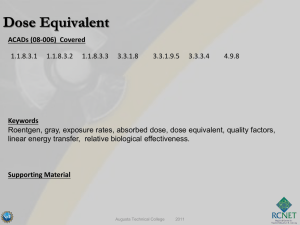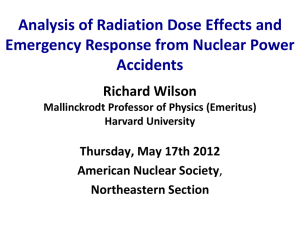Waves & Radiation
advertisement
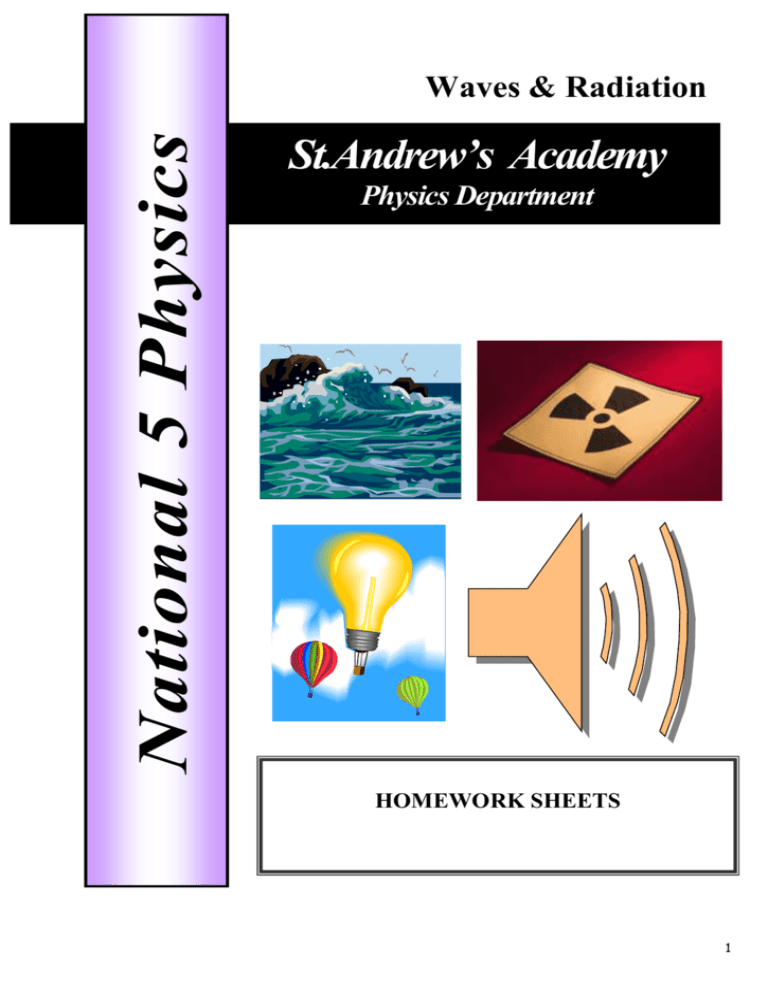
National 5 Physics Waves & Radiation St.Andrew’s Academy Physics Department HOMEWORK SHEETS 1 Homework 1 – The Electromagnetic Spectrum - FINE 1. A student writes the following statements about electromagnetic waves. i. I Electromagnetic waves all travel at the same speed in air. ii. II Electromagnetic waves all have the same frequency. iii. III Electromagnetic waves all transfer energy. Which of these statements is/are correct? A. I only B. II only C. I and III only D. II and III only E. I, II and III 2. List the members of the electromagnetic spectrum in order with the largest wavelength first. 3. What do all the members of the electromagnetic spectrum have in common? 4. How far will radio waves travel in a) 2 m s b) 0.25 m s c) 1 m s. 5. Calculate the wavelength of waves of frequency a) 5 GHz b) 4 MHz c) 200 GHz. 6. Calculate the transmission frequency of Radio Scotland broadcasting on 370 m on the Medium waveband. Give your answer in MHz. 7. Ultraviolet and infrared waves travel to the Earth from the Sun at the speed of light. The Sun is 1.5 x 108 km from the Earth. a) What is the speed of light? b) How long does it take the ultraviolet rays to reach the Earth from the Sun? c) How long does it take the infrared rays to reach the Earth from the Sun? 8. The human body emits infrared radiation with wavelengths from 3 μm (3x106 m) to 6 μm (6 x 106 m). a) Calculate the range of frequencies emitted b) How is this information used in a thermogram? 9. X-rays travel at the speed of light. They have a range of frequencies from 5 x 1014 Hz to 5 x 1016 Hz. a) Calculate the range of wavelengths which correspond to X-rays. b) Use the internet to research one medical use of X-rays. 10. The diagram below represents the electromagnetic spectrum. Identify radiation A. 2 Homework 2 – Atoms and Ionising Radiations 1. Using a diagram, describe the simple model of an atom. 2. (a) (b) (C) Name the three types of radiation. Which type causes most ionisation? Describe an experiment which distinguishes between the three types. 3. The table gives information about radioactive substances used in medicine. a) State what is meant by the term ionisation. b) State a type of ionising radiation not given in the table above. 4. A student obtained the following results when he placed different absorbers between radioactive sources and a Geiger-Muller tube. Absorbing material Air only Count rate in c.p.m. No source present – 20 Source A Source B Source C Air only 678 445 1890 Paper 690 19 1345 Aluminium 682 21 28 Lead 122 18 19 (a) Which source emits only alpha radiation? (b) What type of radiation is emitted by source C? (c) Why does the count rate with source A present not come down to the background count rate, even when lead is the absorber? 3 Homework 3 – Equivalent Dose, Absorbed Dose & Background Radiation 1. Equivalent dose measures the biological effect of radiation. State the unit of equivalent dose. 2. For living material the biological effect of radiation depends on a number of factors. State two of these factors. 3. A lady has a dental X-ray which produces an absorbed dose of 0.3 mGy. Calculate the equivalent dose of this X-ray. 4. A nuclear worker is exposed to a radioactive material producing an absorbed dose of 10mGy. She finds that the material emits particles with a Radiation weighting factor of 3. Calculate the equivalent dose for this exposure. 5. A physics teacher uses a gamma source in an experimental demonstration on absorption. The teacher receives an absorbed equivalent of 0.5 μSv. Calculate her absorbed dose if the Radiation weighting factor for gamma radiation is 1. 6. (a) Alpha particles produce a dose equivalent of 50 mSv from an absorbed dose of 2.5 mGy. Calculate the quality factor of the alpha particles. (b) Why does exposure to alpha radiation increase the risk of cancer more than X-rays or gamma rays? 7. The unit for absorbed dose is the gray, Gy. Explain this term and give another unit for absorbed dose. 8. Calculate the absorbed dose to a radiation worker, mass 80 kg, who absorbs 0.2 J or energy. 9. Calculate the absorbed dose to a radiation worker, mass 60 kg, who absorbs 0.5 J or energy. 11. What is background radiation? 12. What are the main sources of background radiation? 4 Homework 4 – Nuclear Radiation & Activity 1. State what is meant by the Activity of a radioactive source. 2. A radioactive source has an Activity of 12 000 Bq, what is meant by an activity of 12 000 Bq? 3. Activity and absorbed dose are quantities used in Dosimetry. Which row shows the unit of activity and the unit of absorbed dose? 4. What is the activity of a source in which there are 45 000 atoms decaying in 1 minute? 5. What is the activity of a source if there are 17 million atoms decaying in 5 minutes? 6. If the activity of a source is 25 kBq, how many atoms decay in 30 s? 7. The activity of a source is 3 MBq, how may atoms decay in 5 min? 5 Homework 5 – Half-life 1. What is meant by the half life of a radioactive substance? 2. The activity of a radioactive source drops from 2000 kBq to 125 kBq in 12 days. Calculate the half life of the source. 3. The activity of a radioactive source drops from 2400 kBq to 300 kBq in 9 days. Calculate the half life of the source. 4. A source has an activity of 1000 kBq and a half life of 2 days. What is its activity 6 days later? 5. A source has an activity of 576 MBq and a half life of 10 years. What is its activity 60 years later? 6. A source has an activity of 800 kBq after being stored for 4 days. If the half life is 1 day, what was its initial activity? 7. A source has an activity of 1800 kBq after being stored for 72 s. If the half life is 24 s, what was its initial activity? 8. The following data was obtained from an experiment to determine the half life of a radioactive source: (a) Describe how you could carry out this experiment. (b) Determine the half-life of the radioactive source. 9. The table shows the count rate of a radioactive source taken at regular time intervals. The count rate has been corrected for background radiation. What is the half-life in minutes of the isotope? A 10 B 15 C 20 D 30 E 40 10. A sample of iodine-131 (which has a half-life of 8 days) is delivered to a hospital 24 days before it is given to a patient. The activity of the iodine-131 when it is given to the patient is 6 MBq. Calculate the initial activity, in MBq, of the sample when it was delivered to the hospital. 6 Homework 6 - Nuclear Reactions 1. In the following passage some words have been replaced by letters X and Y. In a nuclear reactor, fission is caused by X bombardment of a uranium nucleus. This causes the nucleus to split releasing neutrons and Y. Which row gives the words for X and Y? 2. Control rods in a nuclear reactor A B C D E absorb neutrons contain uranium produce neutrons remove heat from the reactor slow down neutrons. 3. State two advantages of nuclear power. 4. State two disadvantages of nuclear power. 5. The following is an extract from a student’s notes on nuclear fission. I II III The nucleus splits into two parts. Neutrons are emitted. Two nuclei join together. Which of the statements is/are correct? 6. Describe how we use nuclear fission to generate electricity. 7. Describe nuclear fusion. 7 Homework 7 – research task: Choose one of the research tasks below Task 1 Task 2 8 Homework 8 – research task: Choose one of the research tasks below Task 1 Nuclear Power – good or bad Task 2 Nuclear weapons – good or bad 9

